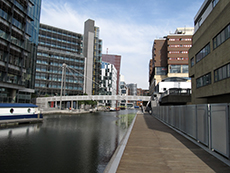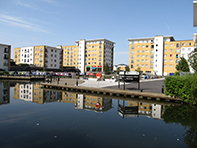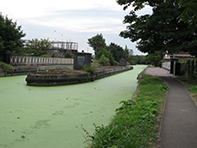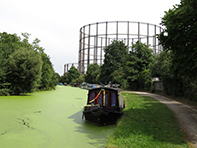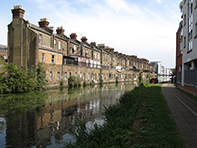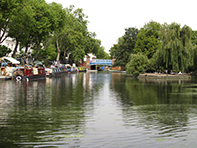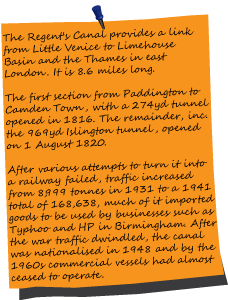
Gleaming new warehouses and housing now line the canal. Swans gather but so do plastic bags, cigarette packets and beer cans. Someone clearly drinks a lot of Polish lager and doesn’t feel the need to recycle the cans. At bridge 20 there's an extensive and colourful mural lauding Southall and then the area becomes pleasantly residential with houseboats leading to the ornate bridge 19. Tranquil greenery mean you could have escaped to the country as you cross from Hillingdon into Ealing and approach Willowtree Marina. During this initial section of the arm there were once several branches, that have now disappeared, serving the local brick industry whose products built the expanding metropolis, the marina occupies a former wharf that was also involved with the movement of explosives during the Great War.
The towpath improves nearing Engineer’s Wharf with its pricey moorings and adjacent Grand Union Village built on the site of an old brick works, land fill site and more recently Taylor Woodrow's headquarters. There are 700 'eco homes' here together with shops, medical and leisure facilities. Further on Marnham Fields is reached, part of the Northolt and Greenford Country Park consisting of very pleasant meadows, scrub and woodlands. There's an attractive wooden footbridge but unfortunately this peaceful environment is soon extinguished by the A40 carried by bridge 17b.
High above the Highline Yachting Club is the impressive Dawoodi Bohra mosque but then factories take over as the backdrop to a lengthy row of double banked boats reaching the Central Line. The canal is enveloped in green as you progress to Lyons Dock and a line of boats at Greenford Moorings but it is only a veneer concealing industry on both sides. Next to a winding hole is the Black Horse pub at bridge 15, then Greenford Quay takes over, a series of residential developments transforming both sides of the canal joined by a smart new bridge (15AA).
Quickly though, greenery returns with open spaces, playing fields and Perivale Wood Nature Reserve. Skirting Horsenden Hill and passing Horsenden Farm moorings, you head straight through Terry and June country with neat semis on one side, Sudbury golf course opposite and boats in the middle. The canal is wide and straight passing the West London Motor Cruising Club and Piggery Bridge winding hole and then, as Alperton is approached, high rise blocks tower above you.
Alperton isn’t pretty and it doesn’t get better. After the Piccadilly Line, industrial estates on the far side give way to new apartments before reaching the roar of the North Circular Aqueduct. The IRA tried to blow up the original aqueduct in 1933, this replacement dates from 1993 and crossing it is a bleak experience. The adjacent recycling centre teams up with graffiti to maximise the unpleasantness. Hemmed in by factories but gradually much quieter, the canal becomes livelier near the Grand Junction Arms. Nature isn’t entirely absent as passing the former Acton Lane power station the canal is very quiet and you can pick blackberries on your way through Harlesden to Old Oak Wharf, where there is a recycling centre financed by British Waterways and Transport for London to encourage local businesses to use the canal to move freight.
The canal’s aspect now opens up, marshalling yards are below on the right with Wormwood Scrubbs in the distance. Factories, some nearing their sell by date, remain on the other side up to the highly decorated surroundings of Mitre Wharf and its long term moorings. The canal's urban feel relents passing Kensal Green moorings, giant gas holders used to stand guard here over the canal but they have been demolished. Opposite, hidden behind trees, is All Souls' Cemetery. Inspired by the Père Lachaise Cemetery in Paris, it opened in 1833, covers 73 acres, serves all faiths and is where the Brunel family and other luminaries are buried.
After traversing several filled-in wharfs at Ladbroke Grove, houses and apartments back onto the water, including the marvellous sweep of houses along the Harrow Road, and any rubbish has disappeared for this is Kensington and Chelsea / Westminster borders. It is now a pleasant walk to the Union Tavern beer garden especially when, after the attractive blue Wedlake Street Footbridge, the four acre Meanwhile Gardens with its factory chimney are adjacent to the tow path
However, soon looming above the boats that have been moored bow to stern since Kensal Green is the graceful concrete curve of the Westway that kisses the canal before veering off to follow the railway to Paddington. From bridge 3 and St Mary Magdelene church, with its Grand Junction cafe, the boats are double banked on the tow path side. This is the case all the way to the old Toll House and Paddington Stop Lock at Little Venice with permanent houseboats on the far side following Ranelagh Road Footbridge.
Now an expensive and celebrity riddled suburb, at the time of the canal’s construction this was a small village on the outskirts, the area has been referred to as ‘Browning’s Pool’ after the poet who lived locally but it is a myth he coined the phrase ‘Little Venice’ which has really only been in use post-1945. The benches along Delamere Terrace offer the opportunity to rest your feet and watch the people go by and at the far side of the willow clad island a tourist boat departs to the Regent’s Canal which boasts both London Zoo and Camden Lock before joining the Thames at Limehouse.
The Grand Union disappears under bridge 2 and there's certainly no need to go hungry or thirsty around here as you pass a plethora of shops and bars both on the water and the tourist laden tow path. There's a new entrance to Paddington Station for the Elizabeth Line and then turning a corner the branch comes to an end at the 400 yard long, 30 yards wide Paddington Basin adjacent to St Mary's Hospital where penicillin was discovered.
Once there were wharves, warehouses, livestock pens, and tons of manure which was transported to the basin from the capital’s streets. All this has now been replaced by the Paddington Waterside scheme that includes shops, apartments and offices with the north side branded Merchant Square. Before finishing the walk take a look at two innovative pedestrian bridges that straddle the basin and are opened at regular times. First the Rolling Bridge that curls up like a caterpillar and then the Fan Bridge that resembles a Japanese hand fan when raised.
View Paddington Arm in a larger map
